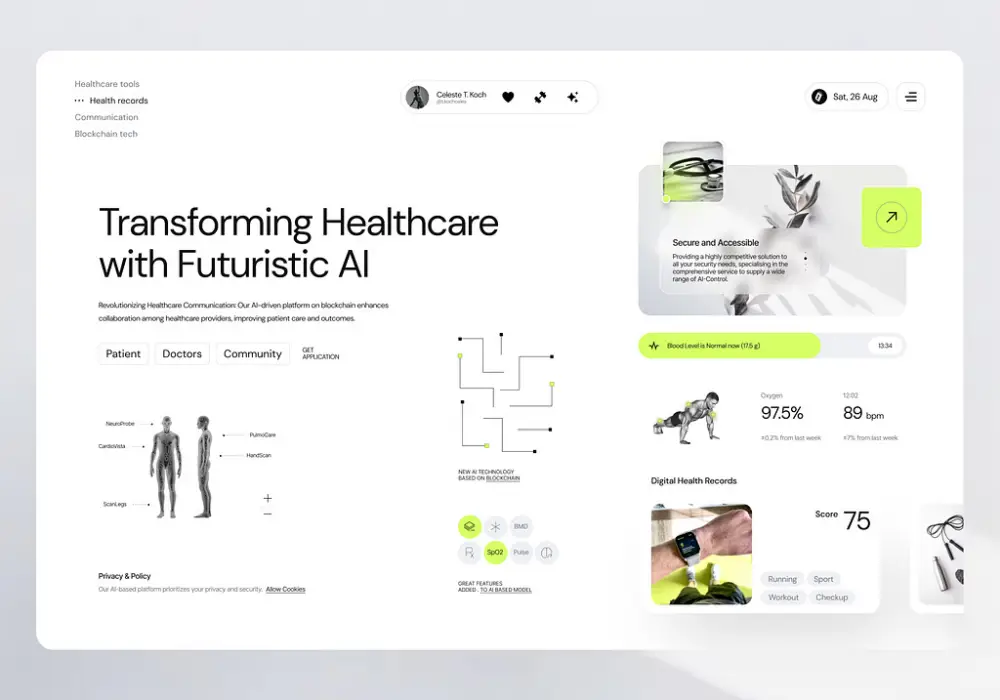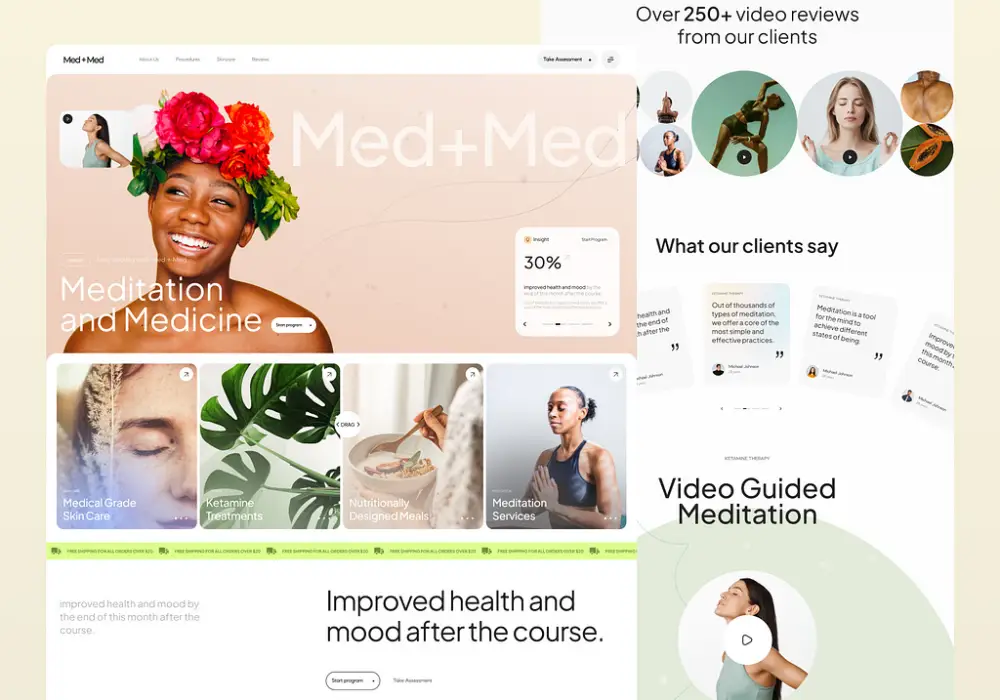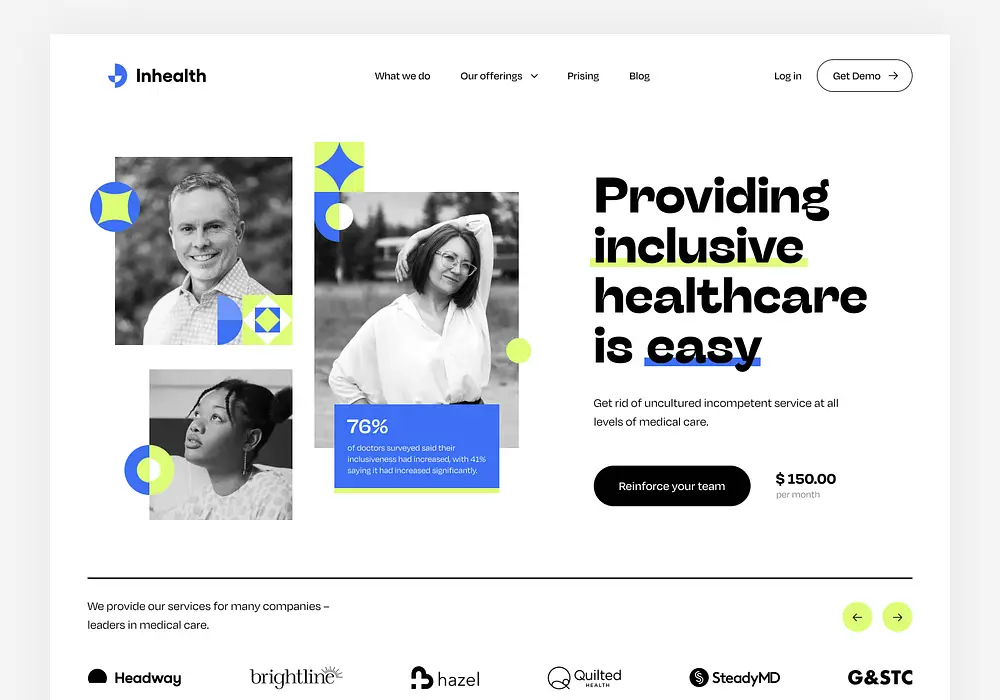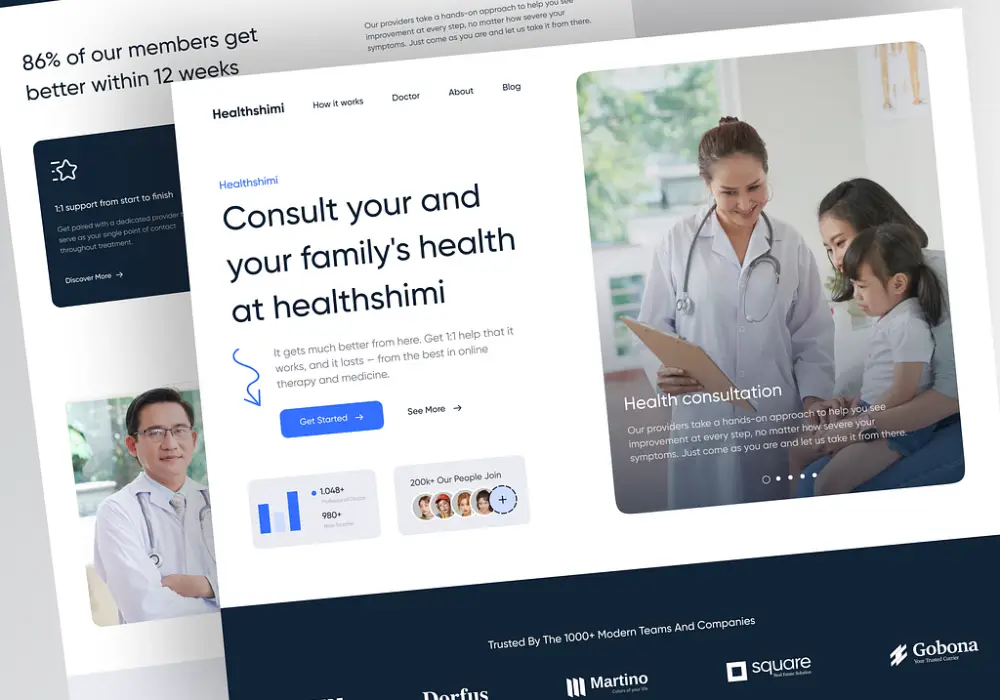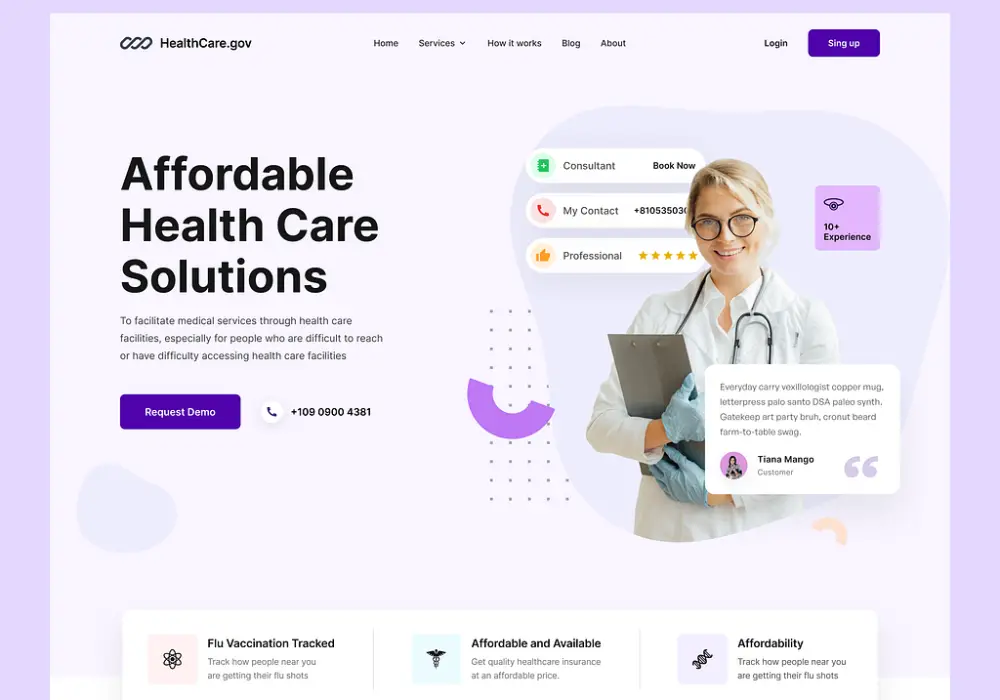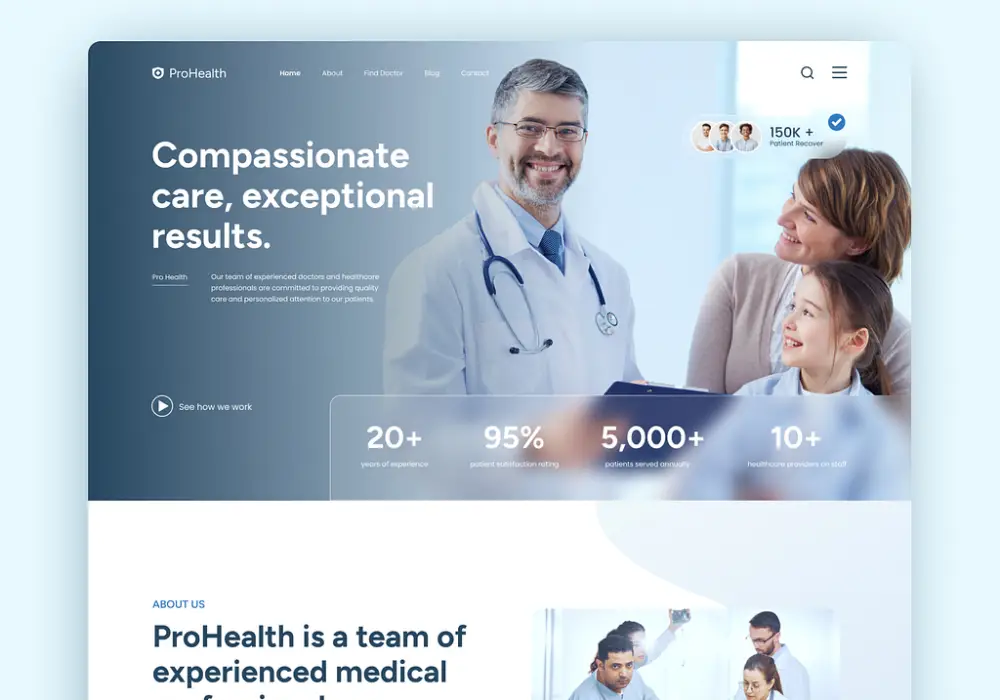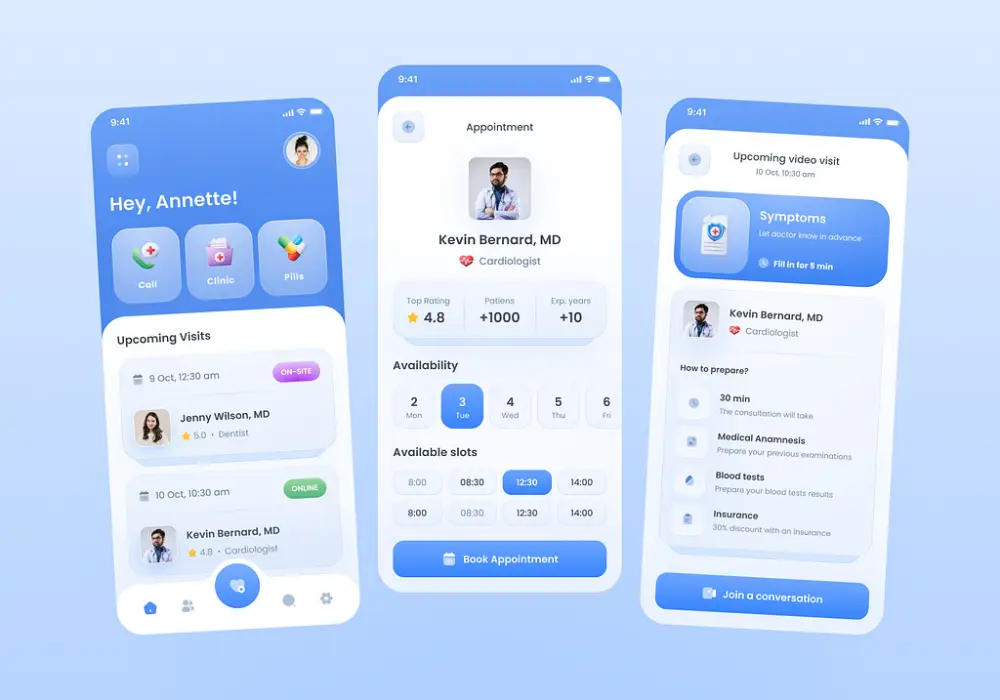Step-by-Step Guide To Healthcare Website Redesign
- TECHVIFY Team
- 0 Comments
In the dynamic world of healthcare, where the pulse of technology beats in sync with the heart of patient care, a well-crafted website is not just a digital front door to your services, but a beacon of trust and a guide to wellness. As we venture further into the 21st century, the intersection of healthcare and technology grows ever more critical, and the need for a website that accurately reflects this evolution becomes paramount.
Now, more than ever, a website redesign in the healthcare industry is not merely a cosmetic update; it’s a transformative process that can redefine how care is accessed and delivered. With a pinch of creativity, a dash of strategy, and a spoonful of technical expertise, a healthcare website can transcend its traditional role. It becomes a healing space, a source of knowledge, and a reliable companion on the patient’s journey towards health and well-being.
As we dive into the essentials of Healthcare Website Redesign, TECHVIFY will guide you on a to create digital experiences that resonate with compassion, accessibility, and innovation.
But before that, here are some interesting facts & figures about the Healthcare Industry:
- As of 2022, approximately 76% of U.S. hospitals were utilizing telehealth services (American Hospital Association).
- The global telemedicine market was expected to grow from $79.79 billion in 2020 to over $396 billion by 2027, at a CAGR of 25.5% (Fortune Business Insights).
- Nearly 60% of patients found telehealth visits more convenient than in-person visits (McKinsey & Company’s consumer survey).
- Around 90% of healthcare executives were developing or implementing an AI strategy, with many applications aimed at diagnostics and clinical support (Optum’s Annual Survey on AI in Health Care).
1. The Imperative of Healthcare Website Redesign
Healthcare website redesign
Redesigning your healthcare website is not just an update; it’s a strategic move that can have far-reaching implications for your practice or organization. Here’s why you should consider giving your healthcare website a fresh look and functionality.
- Improve UI/UX: A user-friendly interface and a smooth user experience are crucial for a healthcare website. Patients and visitors seek information that is easily accessible and understandable. A redesign can streamline navigation, declutter the interface, and ensure that users can find what they need with minimal effort and time.
- Integrate New Technologies: The healthcare industry is continuously evolving with advancements in technology. By incorporating tools like generative AI, you can offer personalized content and services. For instance, AI chatbots can interact with patients 24/7, answering their queries, scheduling appointments, and providing support, significantly enhancing user engagement.
- Enhance Loading Speed: The loading speed of your website is vital. A delay of even a few seconds can frustrate users, leading to higher bounce rates and lost opportunities for patient engagement. A redesign can optimize the site’s performance, ensuring that pages load quickly, which is essential for retaining visitors’ attention.
- Boost SEO Performance: Search engine optimization is key to making your website visible to more potential patients. A redesign can address SEO from the ground up, ensuring that your site structure, content, and metadata are all optimized for search engines, which can increase your rankings and drive more organic traffic.
- Improve Mobile Responsiveness: With an increasing number of users accessing websites from mobile devices, a mobile-responsive design is non-negotiable. A healthcare website redesign should ensure that the site is fully functional and looks great on any device, from desktops to smartphones.
- Compliance and Security: Healthcare websites must comply with regulations such as HIPAA in the United States, which safeguards patient privacy. A redesign can help ensure that your website meets all legal requirements and employs the latest security measures to protect sensitive patient data.
- Update Content Management System (CMS): The right CMS can make a world of difference in how easily you can update and manage your website’s content. Upgrading to a more modern CMS can provide more functionality, better support, and enhanced security.
- Integrate Patient Portals: Patient portals have become an expectation for modern healthcare providers. They offer patients a secure way to access their health information, communicate with healthcare providers, and manage appointments. Integrating a patient portal is a valuable feature that should be considered in a website redesign.
2. Core Drivers Behind a Healthcare Website Redesign
Healthcare website
Embarking on a healthcare website redesign can be driven by a multitude of reasons. If you’re noticing any of the following signs, it might be time to consider a revamp of your digital presence:
- You’ve Outgrown Your Website: Like a hermit crab searching for a new shell, you may find that your current website no longer fits the expanding needs of your healthcare practice. Growth in services, patient base, or content can necessitate a more robust and scalable website that can grow with you.
- Your Website Isn’t Showing Results: If your website isn’t converting visitors into patients, or isn’t facilitating the patient journey from research to treatment effectively, it’s a clear sign that a redesign is needed. Analyzing user behavior can reveal pain points and conversion barriers that a redesign can address.
- Patients Don’t Use Your Website: A healthcare website should be a go-to resource for existing and potential patients. If analytics show low engagement or feedback indicates that patients find the website unhelpful, it’s time to reassess and redesign to better meet user needs.
- You Can’t Make the Changes You Want or Important Features Don’t Work: A website that is difficult to update or plagued with non-functional elements can hinder your ability to provide timely and reliable information. Modernizing your site’s infrastructure can resolve these issues and allow for easier content management.
- Your Competitors Have Better Websites: In the digital age, your online presence is often the first impression you make. If competing healthcare providers offer more intuitive, informative, and user-friendly websites, it’s likely they’re capturing more interest. A redesign can help you stay competitive and even stand out.
- You Aren’t Getting Enough Visitors to Your Site: Low traffic can be symptomatic of deeper issues such as poor SEO, outdated design, or lack of mobile optimization. Redesigning your website with a focus on these aspects can increase visibility and attract more visitors.
Each of these reasons underscores the necessity of a healthcare website redesign, not only to keep pace with the digital landscape but to ensure that your online presence effectively supports your mission to deliver excellent healthcare services.
Have a Project Idea in Mind?
Get in touch with’s experts for a free consultation. We’ll help you decide on next steps, explain how the development process is organized, and provide you with a free project estimate.
3. Navigating Your Healthcare Website Redesign: A Strategic Blueprint
Embarking on a healthcare website redesign is a journey that requires careful planning and execution. It’s a process that can significantly enhance how you connect with patients and present your services to the world. To make this journey a successful one, we’ve crafted a step-by-step guide to help you navigate the intricacies of a healthcare website redesign, ensuring that every aspect of your online presence is optimized for maximum impact and user satisfaction.
3.1 Conducting a Thorough Site Audit
Website redesign in healthcare industry
A comprehensive site audit serves as the cornerstone of a successful healthcare website redesign. It’s an invaluable step that allows you to understand the strengths and weaknesses of your current online platform. Here’s how to delve deep into the anatomy of your website and prepare for a revitalization:
- Evaluate Functionality and Performance: Begin by assessing what elements of your website are performing well. Identify features that are appreciated by users and should be retained or enhanced. Conversely, pinpoint the aspects that are falling short. Is your site’s navigation intuitive? Are load times snappy or sluggish?
- Assess Mobile Responsiveness: In today’s mobile-first world, your website must look and function flawlessly on smartphones and tablets. Test responsiveness across various devices to ensure a seamless experience.
- Analyze Visual Cohesion: Examine whether your website’s visual elements reflect your current brand identity. Are the colors, fonts, and imagery consistent with your branding guidelines and appealing to your target audience?
- Review Current Analytics: Analyze data to understand user behavior on your site. Metrics such as bounce rate, session duration, and conversion rates can provide insights into your website’s effectiveness and areas that require attention.
- Interactivity and User Engagement Tools: Assess the tools available to users, such as appointment forms, chatbots, and educational resources. Are these features being utilized effectively? Do they need to be updated or replaced to better serve your visitors?
- Gather Feedback: Collect and review feedback from patients and staff regarding their experiences with the website. This can offer valuable perspectives that might not be apparent from analytics alone.
- Content Accuracy and Accessibility: Check that all information on your site is current, medically accurate, and easy to find. Content should be organized logically and searchable.
- Search Engine Optimization (SEO): Evaluate your technical SEO setup and local search rankings. Understanding your organic search visibility can guide you in optimizing for better rankings post-redesign.
- CMS and Customization: Review your current CMS capabilities. Determine what you can easily update and what requires developer intervention. This assessment will help you decide whether to upgrade your CMS.
- Resource Allocation: Consider the resources at your disposal, including time, talent, and budget. How much can be managed internally? What investment is required for external expertise?
Leverage the expertise of a third-party auditor if needed. They can offer an impartial and professional assessment of your current site, working collaboratively with your team to identify all the leverage points that can transform your website into a state-of-the-art healthcare portal.
3.2 Assembling Healthcare Website Redesign Team
Healthcare website design
The success of your healthcare website redesign largely hinges on the composition and coordination of your project team. This team is the engine behind the transformation, with each member bringing unique skills and perspectives to the table. Here’s how to assemble a team that’s fit for the challenge:
- Identify In-House Talent: Start by taking stock of the skills and expertise available within your organization. Do you have adept web designers, savvy developers, creative copywriters, and astute IT professionals on staff? Understanding your team’s capabilities will help you allocate roles effectively.
- Resource Allocation: Determine the level of commitment your in-house team can make. Consider their current responsibilities and how much time they can realistically dedicate to the project without compromising their primary duties.
- Decision on Outsourcing: Decide which tasks, if any, should be outsourced. This might depend on the specific skills required, the complexity of the project, and the extent of in-house expertise. Outsourcing can bring fresh perspectives and specialized skills to the project but needs to be balanced against budget constraints.
- Stakeholder Involvement: Clearly identify key stakeholders within your organization. These individuals should represent the diverse needs and insights from different departments, such as clinical services, marketing, and administration. Determine at which stages their input is crucial and how it will be integrated into the decision-making process.
- Approval Processes: Establish a clear protocol for approving content and design elements. This should outline who has the final say and how feedback loops will be managed to avoid bottlenecks and ensure timelines are not adversely affected.
- Role Definition and Availability: Assign specific roles to each team member, such as project manager, UX/UI designer, content strategist, SEO specialist, developer, and quality assurance tester. Assess each member’s availability to prevent overcommitment and determine how this will influence the project timeline.
By carefully selecting and empowering the right mix of individuals for your redesign team, you can create a collaborative environment that blends in-house knowledge with external expertise. This synergy will not only drive the project forward but also ensure that the end result is a healthcare website that’s both functional and reflective of your organization’s values and goals.
Remember, a well-structured team with clear roles, responsibilities, and processes is the backbone of a seamless and successful website redesign. Take the time to get this right, and you’ll set the stage for a project that runs smoothly from inception to launch.
Let’s talk
A consultation with the Client Relationship Manager, who represents TECHVIFY, without any commitment from your side, will give you:
- Structured and clear vision of your future application
- Information about how our software development company guarantees 100% on-time and on-budget delivery
- Recommendations for choosing the tech stack
- Advice on further steps
- Business-side recommendations
- Rough project estimation on software development
TECHVIFY is right where you need. Contact us now for further consultation:
3.3 Crafting Your Strategic Framework
In the realm of healthcare marketing, a deliberate and strategic approach is not just beneficial—it’s essential. The most impactful healthcare websites are those born from a strategy that speaks directly to the ideal patient demographic while fulfilling specific business objectives.
To create a website that resonates with visitors and drives results, every design decision, from functionality to content, must be made with intention. Your website should be a digital embodiment of the care and expertise patients expect from your organization.
Here’s how to ensure that your strategy development process is patient-centered and goal-oriented:
- Identifying Your Patient Demographics: Define who your ideal patients are. Understanding your target audience is key to tailoring your website’s messaging and design to their needs.
- Highlighting Your Services: Determine which healthcare services you wish to highlight. Identify what your patients are actively seeking and which of your services they may not yet be aware of.
- Addressing Patient Concerns: Acknowledge and address common questions and concerns patients have. What information do they require to choose your services confidently?
- Empathizing with Patient Emotions: Consider the emotional state of patients when they are looking for healthcare options. How can your website alleviate their concerns and offer reassurance?
- Understanding Access Patterns: Investigate how your target patients access the internet. Are they more likely to use a mobile device, or do they prefer a desktop experience?
- Enhancing Functionalities: Brainstorm website functionalities that could help patients understand and feel comfortable with your services. Interactive tools, FAQs, patient testimonials, and virtual tours can be very effective.
- Meeting Broader Business Goals: Reflect on how the website design can cater to broader business objectives. Could online appointment booking increase efficiency? Might a blog establish thought leadership in your field?
The foundation of a successful healthcare website is a deep understanding of the personas you’re trying to reach—ranging from patients and referring physicians to caregivers and family members. This insight, often referred to as persona research, is the critical first step in building a website strategy that is both effective and empathetic, ensuring your digital presence is as professional and caring as the services you provide.
3.4 Setting a Realistic Timeline
Redesign healthcare website
A pragmatic approach to scheduling is crucial for the successful completion of your healthcare website development project. Understanding the realistic timeframe for launching a redesigned website involves a comprehensive evaluation of your organization’s unique requirements, budgetary constraints, and available resources.
Here’s how to craft a well-considered timeline that aligns with the diverse facets of your project:
- Scope and Review: Begin by mapping out the entire project scope and each phase that requires thorough review and approval. Incorporate adequate time for these processes to avoid rushed decisions.
- SEO and Compliance: Allocate time for the creation of SEO-enhanced content that also adheres to HIPAA regulations. Your content strategy should effectively engage your audience while meeting legal and search optimization criteria.
- Design and Approval: When planning the design phase, be realistic about how long the approval process will take. Make sure to include time for necessary revisions and iterations based on stakeholder feedback.
- Custom Tools and Testing: If you need custom tools or special functionalities, incorporate additional time for their design, development, and rigorous testing to ensure seamless integration.
- Technical Preparations: Don’t overlook technical tasks such as developing a redirect strategy, link testing, and implementing new code. These behind-the-scenes activities are critical for a smooth transition.
- Reassessing Capabilities: Critically assess whether in-house resources are adequate for the tasks at hand or if outsourcing might be a more efficient use of time and funds. Often, experts can execute specialized tasks more quickly and effectively.
- Stakeholder Review Time: Plan for and enforce review periods for stakeholders who need to sign off on design choices and other project deliverables. This ensures that everyone is on the same page and that no part of the process is bottlenecked by waiting for approvals.
Setting a realistic timeline is an exercise in balancing ambition with the practicalities of your organization’s operational capacity. By carefully considering each step, from content creation to stakeholder reviews, you can establish a schedule that is both attainable and reflective of the quality and reliability your healthcare organization stands for.
3.5 Implementation and Deployment
Transforming your healthcare website from blueprint to reality is both an exciting and complex endeavor. With a strategic foundation in place, the build and launch phases can proceed more smoothly, but you should always remain agile to navigate the inevitable challenges that arise.
As your project transitions into the active design and development stages, consider these key actions to maintain momentum and ensure a successful launch:
- Monitor Progress: Keep a close eye on your team’s progress. Establish regular check-points and progress reports to ensure everything stays on track.
- Communication Channels: Encourage open communication. Give team members the freedom to speak up if deadlines are at risk, allowing for proactive adjustments to the schedule.
- Task Management: Understand the sequence of tasks. Identify which steps are dependent on others and which can progress concurrently to maximize efficiency.
Here are some best practices gleaned from successful healthcare website projects:
- Prioritize Wireframes: Allocate sufficient time to wireframing. This step is crucial to avoid costly and time-consuming revisions later in the design and development process.
- Site Architecture Planning: Define your site’s architecture early on. This includes the structure of pages, navigation labels, interlinking strategies, keyword targets, and the user journey, all designed to align with your objectives.
- Content Coordination: Synchronize your design and content teams. Ensure that copy and design templates are cohesive, and include all necessary metadata, URL naming conventions, and specific content details early on to streamline page builds.
- Incorporate Functionality Testing: Dedicate time for thorough testing of all interactive elements. Addressing functionality details early and testing rigorously will minimize post-launch issues.
- Manage Approvals: Keep stakeholders involved. Securing approvals at each major project milestone helps prevent delays and reduces the need for rework.
- Allow for Detailed Production: Recognize the scope of content. Healthcare websites often feature numerous pages, each requiring meticulous attention to detail. Ensure your timeline accommodates the careful addition of content to every page, including imagery, formatting, and other elements.
By adhering to these practices, you can better manage the complexities of building and launching a healthcare website. It’s a balancing act of adhering to the plan while also being flexible enough to adapt to new challenges. With careful execution and ongoing project management, your website is set to become a dynamic, patient-centric online presence.
3.6 Continuous Enhancements & Updates
Healthcare website
Your healthcare website is not just a digital front door for patients; it’s a dynamic marketing tool that should evolve with your strategy. Post-launch, the focus shifts to leveraging your website to amplify your marketing initiatives and support your overall business objectives.
Here’s how to harness the full potential of your new website within your marketing ecosystem:
- Optimize Landing Pages: Assess which pages serve as effective entry points from your ad campaigns or social media drives. These pages should be optimized to convert visitors from specific marketing channels.
- Email Marketing Integration: Determine how to incorporate website content into your email marketing flows. Links to relevant pages can provide additional value to your subscribers and drive traffic to your site.
- Social Media Synergy: Align your website content with your social media strategy to create a cohesive online presence. Shareable content from the website can enhance social engagement.
- Phase Two Features: Reflect on the project’s initial phase. Consider which features, content, or functionality were set aside due to time or budget constraints and prioritize them for future updates.
- Content Enhancement: Identify areas where content can be improved or expanded. Invest resources in areas that will increase user engagement and meet strategic goals.
- SEO and Content Strategy: Plan for the regular addition of fresh content to improve SEO rankings. Assign responsibility for ongoing content creation and optimization to maintain and improve online visibility.
- Business Goals Alignment: Explore how your website can contribute to broader business goals. Consider using the site for fundraising, community engagement, or as a platform for media awareness.
- Analytics Review: Regularly review website analytics to understand user behavior and make data-driven decisions. Use insights to refine your marketing strategies and website performance.
- Collaborate with Your Agency: Engage with your web design agency for fresh ideas and insights. Their expertise can help identify new opportunities for website and marketing enhancements.
Maintaining the vitality of your website requires a proactive approach:
- Technical Updates: Keep your website’s technology up to date to ensure security, performance, and compatibility with new web standards.
- Audits and Analytics: Conduct semi-annual website audits and review analytics to identify areas for improvement and to understand user interactions.
- Iterative Improvements: Implement a schedule of regular, manageable updates to keep the website current. This approach minimizes disruption and reduces the burden on your team’s workflow while keeping the site aligned with the latest trends and user expectations.
By making ongoing improvements and integrating your website into your overall marketing strategy, you not only extend the life and efficacy of your website but also create a powerful platform that supports the evolving needs of your healthcare organization and its patients.
How to Find the Best Vendor for Healthcare Website Redesign?
Finding the best vendor for a healthcare website redesign involves a careful evaluation of your current and future needs. Start by reviewing your existing agency's performance: have they evolved with your organization, and does their work reflect the complexity. To find the best vendor for a healthcare website redesign, assess if your current agency's capabilities have kept pace with your organization's growth and if they possess the specialized experience required for healthcare websites.
Examine the quality and complexity of their previous work. If their SEO and digital marketing services are lacking, or if you require a partner offering a broader range of services, consider exploring other agencies with the necessary capacity and expertise to fulfill your project's specific needs.
How to Create User Personas for Healthcare Website Redesign?
To ensure your redesigned healthcare website meets the needs of your audience, it's essential to develop detailed user personas. Start by gathering data through interviews and research to construct profiles for your ideal users, including patients, referring physicians, and administrators.
Understand the unique ways each group interacts with your site and the internet at large, considering their specific lifestyles and needs. This knowledge allows you to tailor the website's design, navigation, and content to communicate effectively with each segment, ultimately enhancing user experience and achieving better outcomes.
TECHVIFY – Global AI & Software Solutions Company
For MVPs and Market Leaders: TECHVIFY prioritizes results, not just deliverables. Reduce time to market & see ROI early with high-performing Teams & Software Solutions.
- Email: [email protected]
- Phone: (+84)24.77762.666




